Improve Oil Recovery Mechanism of Multi-Layer Cyclic Alternate Injection and Production for Mature Oilfield at Extra-High Water Cut Stage Using Visual Physical Simulation Experiment
Abstract
:1. Introduction
2. Methodology
2.1. Experimental Materials and Equipment
2.2. Experimental Parameters and Experimental Program
2.3. Experimental Steps and Procedures
- (a)
- Blending sand with oil: Use Sudan I and black ink to dye the oil and water, respectively. Allow it to fully precipitate for a day after dyeing, then filter the precipitation via filter paper to protect the experimental phenomenon. To ascertain the sand mixing ratio of various plates, prepare 80 mesh and 120 mesh quartz sand, respectively, and test the permeability via the sand-filled pipe.
- (b)
- Filling and sealing with sand: In this experiment, oil and sand are mixed in a certain ratio, well combined, and then filled into two-dimensional flat plate models. The models are then compacted with wooden boards to avoid water channeling during the displacement phase. The device and glass plate are then sealed using sealant, and a steel plate is then added to further compact the seal and achieve a high level of sealing. The glue is then left to dry for two days.
- (c)
- Supplied evenly: Open all valves, examine the device’s air tightness, and if necessary, mix glue to repair any portions with poor sealing before letting it dry. Once the airtightness has been verified, connect the 2PB00C advection pump to saturate the oil. Set the continuous flow mode to 5 mL/min and continue until all production wells are steadily producing oil, at which point the saturation process is complete.
- (d)
- Displacement at constant speed: Set the experimental protection pressure to 5 MPa, connect the UPUMP-100 displacement pump, and choose a constant flow rate of 3 mL/min. This component has an intermediate container for experimental water so that water can be supplied to the model steadily and constantly.
- (e)
- Gathering of data: Adjust the camera position, link to the image recognition program to determine the plane sweep coefficient, and use the computer to gather real-time water-flooding oil sweeping field maps. Keep track of oil and water production data every 30 min to determine the water cut and recovery rates.
2.4. Calculation Method of Sweep Coefficient Based on Image Recognition
3. Results and Discussion
3.1. Sweep Characteristics
3.2. Production Performance Characteristic
4. Conclusions
- (1)
- The water-flood front is rather uniform in the early stage of production, but it rushed along the mainstream line in the mid-stage. After the completion of MCA-IP, the sweep area steadily grows and extends to both sides of the main streamline.
- (2)
- The IOR mechanism of MCA-IP mainly includes reperforation, well-pattern encryption, and asynchronous injection–production. Based on image recognition to quantitatively describe the sweep coefficient, reperforating and encrypting enhance the sweep by about 19.52%, asynchronous injection–production increases the sweep coefficient by about 1.2%, and overall sweep increases by about 20.7%.
- (3)
- Oil production and water consumption are both increased and decreased by MCA-IP. According to the experimental data statistics, the MCA-IP method can increase the oil recovery by about 11% and reduce the water cut by about 6%.
Author Contributions
Funding
Institutional Review Board Statement
Informed Consent Statement
Data Availability Statement
Conflicts of Interest
References
- Gao, J.N. Evaluation Method for Water Flooding Development Effect in Extra High Water Cut Period; China University of Petroleum: Beijing, China, 2019. [Google Scholar]
- Han, D.K. Precisely predicting abundant remaining oil and improving the secondary recovery of mature oilfields. Acta Pet. Sin. 2007, 2, 73–78. [Google Scholar] [CrossRef]
- Jackson, M.D.; Vinogradov, J.; Hamon, G.; Chamerois, M. Evidence, mechanisms and improved understanding of controlled salinity waterflooding part 1: Sandstones. Fuel 2016, 185, 772–793. [Google Scholar] [CrossRef]
- Khurshid, I.; Al-Attar, H.; Alraeesi, A. Modeling cementation in porous media during waterflooding: Asphaltene deposition, formation dissolution and their cementation. J. Pet. Sci. Eng. 2018, 161, 359–367. [Google Scholar] [CrossRef]
- Liu, H.H. Study on Remaining Oil Droplet Dynamic Conditions and Water Flood Efficiency Changing Mechanisms in the Ultra-High Water Cut Period; Southwest Petroleum University: Chengdu, China, 2013. [Google Scholar]
- Makhotin, I.; Orlov, D.; Koroteev, D. Machine Learning to Rate and Predict the Efficiency of Waterflooding for Oil Production. Energies 2022, 15, 1199. [Google Scholar] [CrossRef]
- Waburoko, J.; Xie, C.; Ling, K. Effect of Well Orientation on Oil Recovery from Waterflooding in Shallow Green Reservoirs: A Case Study from Central Africa. Energies 2021, 14, 1223. [Google Scholar] [CrossRef]
- Chaabi, O.; Kobaisi, M.A.; Haroun, M. Quantifying the Low Salinity Waterflooding Effect. Energies 2021, 14, 1979. [Google Scholar] [CrossRef]
- Almarri, M. Efficient History Matching of Thermally Induced Fractures Using Coupled Geomechanics and Reservoir Simulation. Energies 2020, 13, 3001. [Google Scholar] [CrossRef]
- Wang, J.; Liu, H.; Zhang, J. Lost Gas Mechanism and Quantitative Characterization during Injection and Production of Water-Flooded Sandstone Underground Gas Storage. Energies 2018, 11, 272. [Google Scholar] [CrossRef]
- Cui, C.; Li, S.; Yang, Y.; Wang, B.; Wu, Z. Planar zoning regulation and control method of reservoir at ultra-high water cut stage. Acta Pet. Sin. 2018, 39, 1155–1161. [Google Scholar] [CrossRef]
- Cuo, G.; Wenrui, H.; Yiqiang, L.; Ruicheng, M.; Zilin, M. Prediction of oil-water relative permeability with a fractal method in ultra-high water cut stage. Int. J. Heat Mass Transf. 2019, 130, 1045–1052. [Google Scholar] [CrossRef]
- Lee, B.H.; Lee, S.K. Probing the water distribution in porous model sands with two immiscible fluids: A nuclear magnetic resonance micro-imaging study. J. Hydrol. 2017, 553, 637–650. [Google Scholar] [CrossRef]
- Olayiwola, S.O.; Dejam, M. Effect of Silica Nanoparticles on the Oil Recovery During Alternating Injection with Low Salinity Water and Surfactant into Carbonate Reservoirs. In Proceedings of the SPE Annual Technical Conference and Exhibition, Virtual, 26–29 October 2020. [Google Scholar]
- Olayiwola, S.O.; Dejam, M. Comprehensive experimental study on the effect of silica nanoparticles on the oil recovery during alternating injection with low salinity water and surfactant into carbonate reservoirs. J. Mol. Liq. 2021, 325, 115178. [Google Scholar] [CrossRef]
- Olayiwola, S.O.; Dejam, M. A comprehensive review on interaction of nanoparticles with low salinity water and surfactant for enhanced oil recovery in sandstone and carbonate reservoirs. Fuel 2019, 241, 1045–1057. [Google Scholar] [CrossRef]
- Martin, F.D.; Colpitts, R.M. Standard Handbook of Petroleum and Natural Gas Engineering; Gulf Professional Publishing: Houston, TX, USA, 1996; pp. 1–362. [Google Scholar] [CrossRef]
- Li, Z.; Shao, X.; Qiu, Y. Methods and effects of cyclic waterflooding in the southern oilfields of daqing placanticline. SPE Adv. Technol. Ser. 1997, 5, 20–23. [Google Scholar] [CrossRef]
- Yang, Y. Study on the Development and Adjustment of Hydrodynamics in the High Water Cut Stage of XianHe Fault Block Reservoir. Master’s Thesis, China University of Petroleum (East China), Qingdao, China, 2019. [Google Scholar]
- Zhao, X.; Liu, X.; Yang, Z.; Wang, F.; Zhang, Y.; Liu, G. Experimental study on physical modeling of flow mechanism in volumetric fracturing of tight oil reservoir. Phys. Fluids 2021, 33, 107–118. [Google Scholar] [CrossRef]
- Zhang, Y.; Liu, X.; Li, D.; Chang, L.; Liu, G. Physical simulation experiment method of water breakthrough mechanism and plugging effect of horizontal well in tight reservoir. Energy Rep. 2022, 8, 9610–9617. [Google Scholar] [CrossRef]
- Niu, Z.; Yang, Z.; Chang, Y.; Zhang, Y.; Luo, Y. Numerical studies on displacement-imbibition process of pore-network extracted from the microfluidic chip. J. Pet. Sci. Eng. 2022, 225, 110686. [Google Scholar] [CrossRef]
- Li, H.; Wang, K.; Han, X.; Zheng, J. Research on heterogeneous compound flooding system based on dispersed particle gel. Adv. Geo-Energy Res. 2019, 3, 156–164. [Google Scholar] [CrossRef]
- Safonov, E.N.; Lozin, E.V. Enhanced oil recovery methods: Reality, perspectives, scientific problems. Neft. Khozyaistvo Oil Ind. 2003, 4, 46–48. [Google Scholar]
- Chang, H.; Liu, Y.; Lei, Y. A comprehensive workow for real time injection-production optimization based on equilibrium displacement. Adv. Geo Energy Res. 2020, 4, 260–270. [Google Scholar] [CrossRef]
- Li, S.; Hou, S. A brief review of the correlation between electrical properties and wetting behaviour in porous media. Capillarity 2019, 2, 53–56. [Google Scholar] [CrossRef]
- Mahmud, W.M. Impact of salinity and temperature variations on relative permeability and residual oil saturation in neutral-wet sandstone. Capillarity 2022, 5, 23–31. [Google Scholar] [CrossRef]
- Lv, J.R. Hydrodynamic Regulation Approach Mechanism and Application to Pu Taohua Oil Field. Master’s Thesis, Daqing Petroleum Institute, Daqing, China, 2008. [Google Scholar]
- Zhao, C.S.; Lv, J.R.; Yang, D.G. Research on the application of cyclic water flood techniques in Pubei2 block reservoir of Daqing Oil field. Pet. Geol. Recovery Effic. 2008, 6, 76–79. [Google Scholar]
- Hou, R.; Han, T.Z. Experimental Research on Periodic Water Injection for Enhanced Oil Recovery in Cha 12–16 Well Area of Chaheji Oilfield. Pet. Geol. Recovery Effic. 1997, 4, 29. [Google Scholar]
- Li, D.X.; Pu, Y.G.; Xu, X.L. Unstable Waterflooding Fashion in latter Development Period of Liangjialou Oilfield. Pet. Geol. Oilfield Dev. Daqing 2002, 5, 23–26. [Google Scholar]
- Cao, G. To improve development result of low permeability reservoir by cyclic waterflooding. Spec. Oil Gas Reserv. 1996, 3, 24–27. [Google Scholar]
- Dong, W.L.; Li, C. Shuanghe Oilfield Periodic Water Injection Mineral Test. Pet. Geol. Eng. 2001, 15, 29–31. [Google Scholar]
- Wang, Z.X.; Zeng, L.F.; Gu, J.W. Unstable water injection mechanism and its field application in loose sandstone reservoir. Pet. Geol. Oilfield Dev. Daqing 2008, 27, 59–63. [Google Scholar]
- Wang, X.L.; Wang, J.L.; Wang, D.L. Study on cyclic water injection test in Gasikule Oifield. Spec. Oil Gas Reserv. 2005, 12, 50–52. [Google Scholar]
- Weng, G.F.; Deng, Z.X.; Zhang, Z.S. Experimental study on periodic water injection of Lun 16 block in Ziyin Oilfield. Pet. Geol. Eng. 2007, 21, 48–51. [Google Scholar]
- Zhang, B.; Jin, S.C.; Xu, Y.L. Pilot test of unstable water injection in Luo 4 well block of Jiyuan Oilfield. Petrochem. Ind. Appl. 2010, 29, 54–56. [Google Scholar]
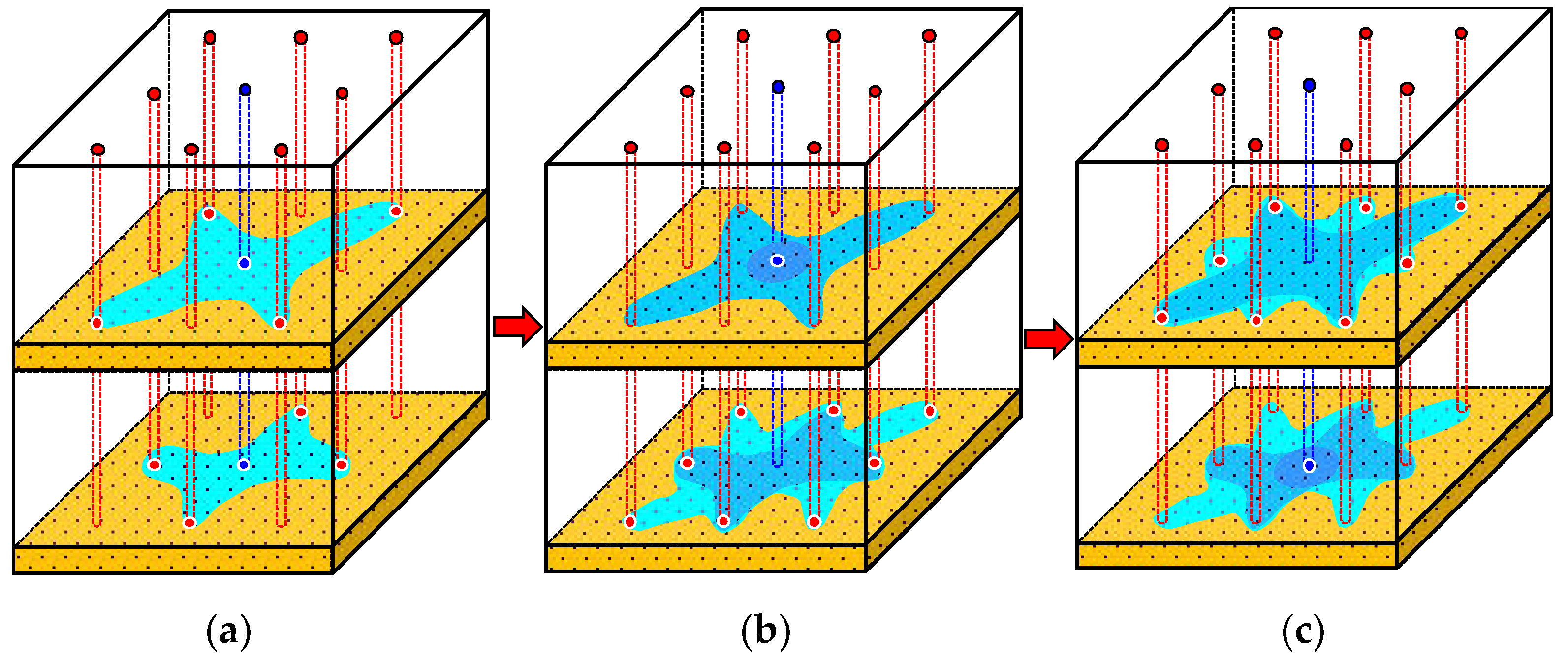
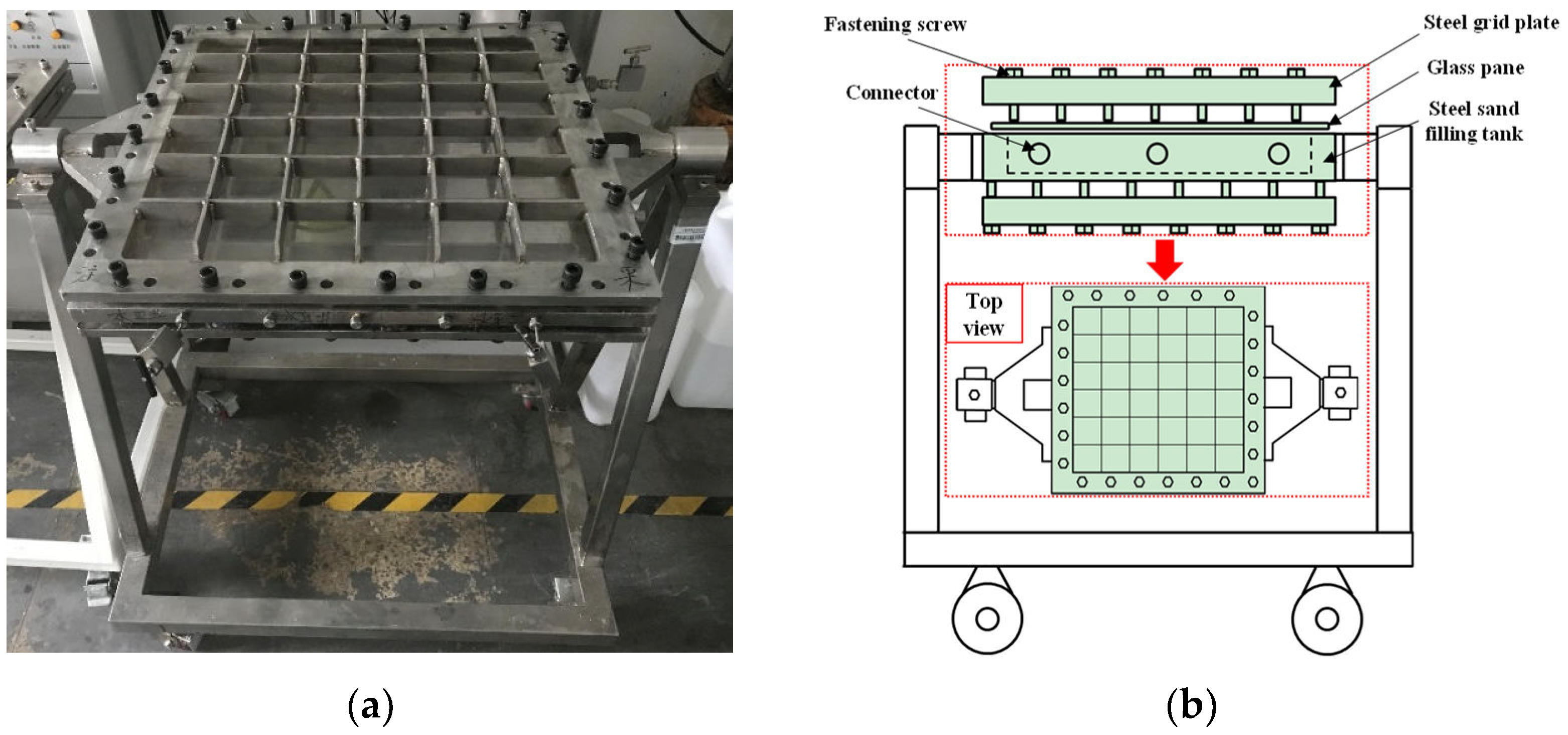


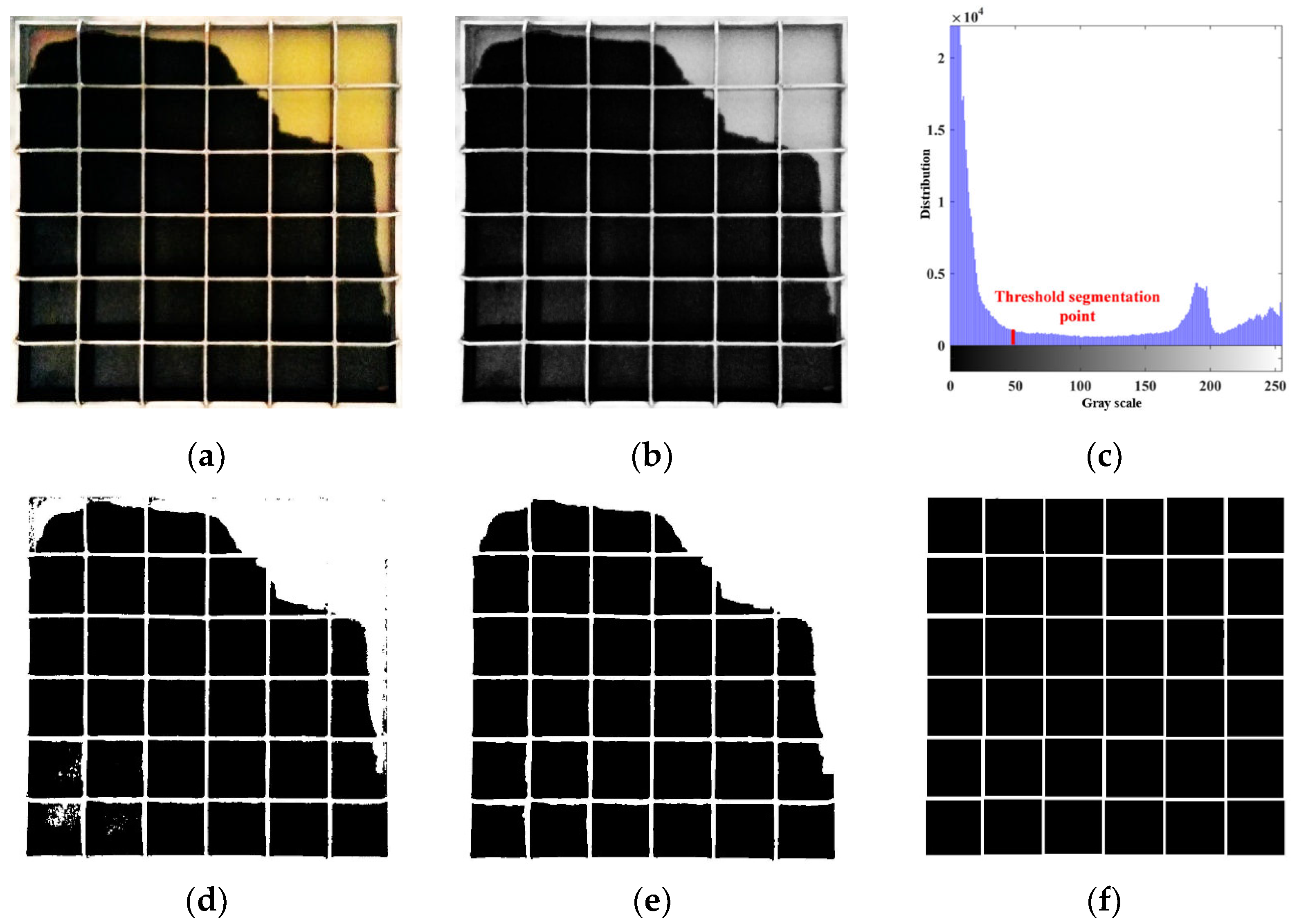
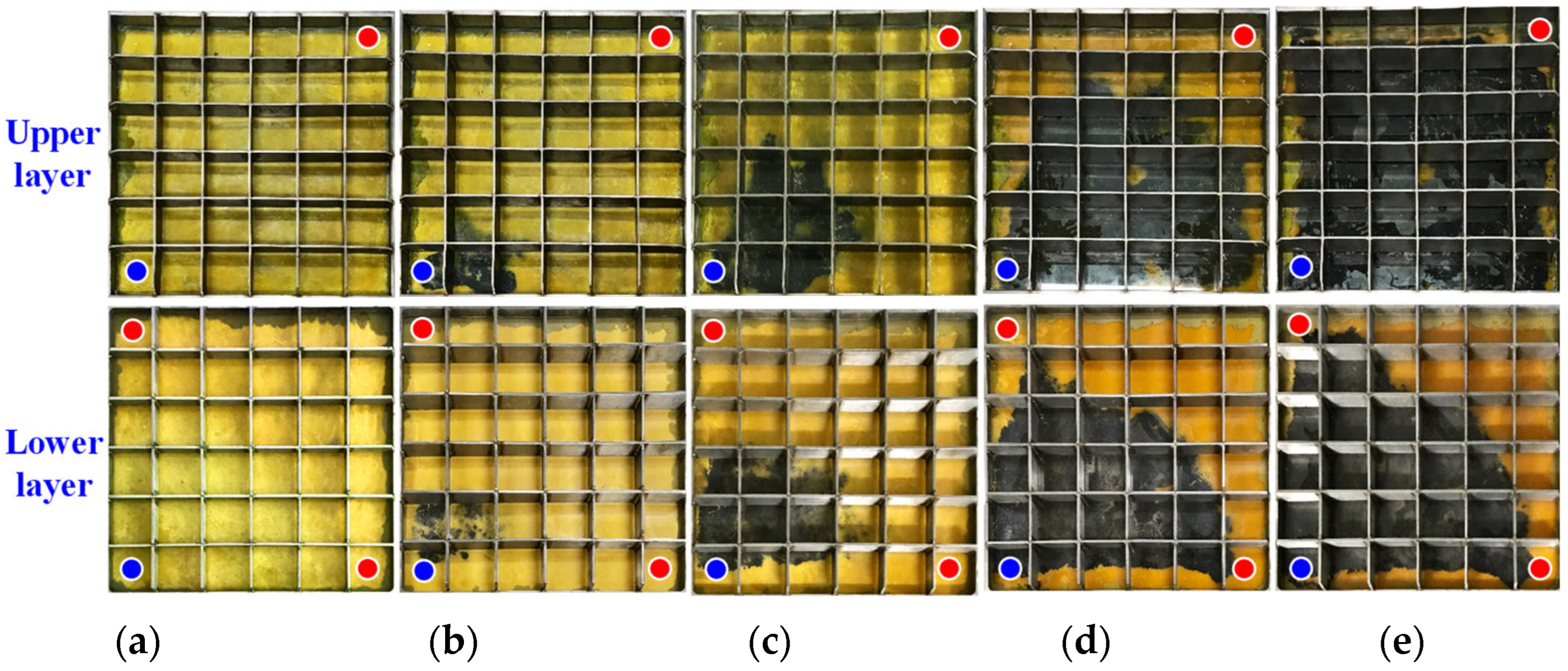
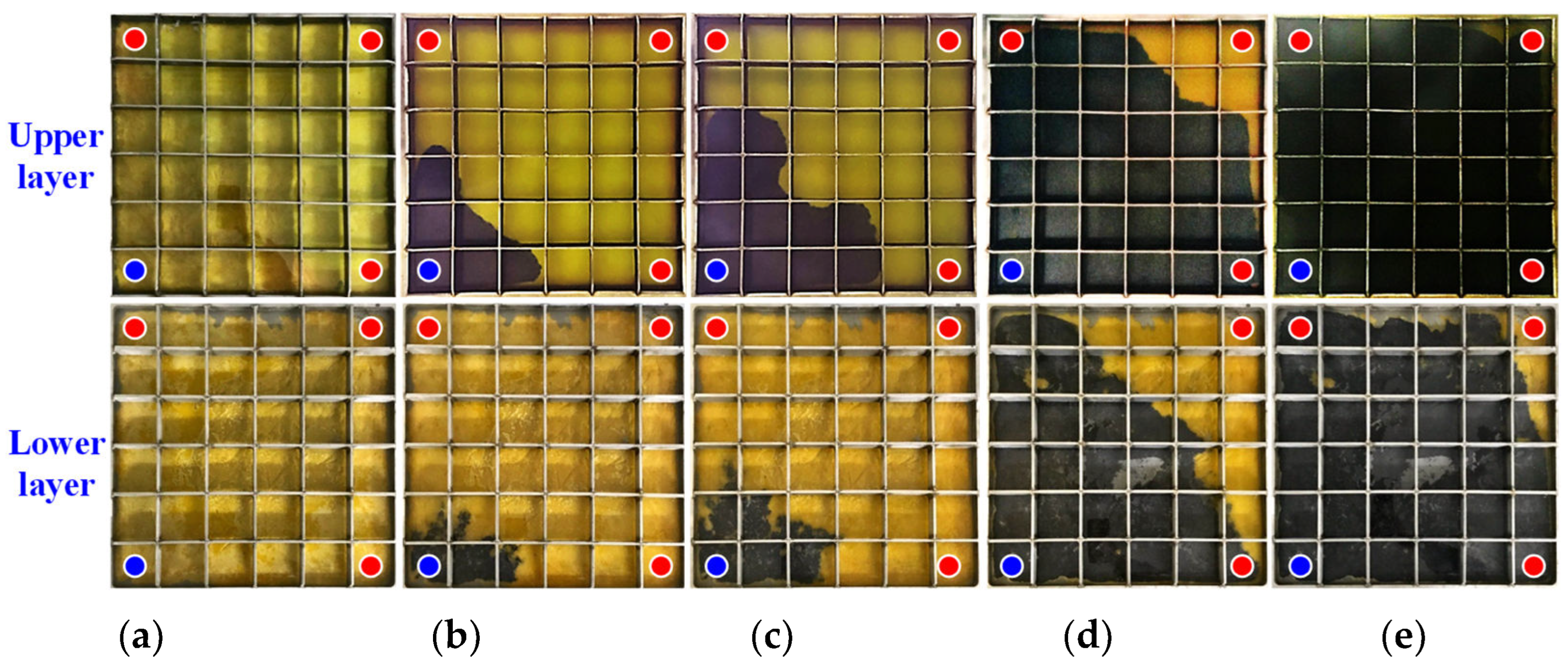




| Ion Type | Ion Content /mg·L−1 | Ion Type | Ion Content /mg·L−1 | Total Salinity /mg·L−1 |
|---|---|---|---|---|
| K+ + Na+ | 22,989 | Cl- | 450,202 | 527,846 |
| Ca2+ | 44,544 | NH4+ | 1188 | |
| Mg2+ | 7357 | Br- | 1566 |
| Similarity Criterion | Formula Expression | Oil Reservoir Parameters | Physical Model Parameters |
|---|---|---|---|
| geometric similarity | Similar length–width ratio: L1/L2 Similar length–height ratio: L1/H Similar porosity: ϕ | O1 porosity: 24.7% O3 porosity: 22.5% O1 permeability: 500 mD O3 permeability: 200 mD | Flat1 porosity: 25% Flat2 porosity: 22% Flat1 permeability: 3000 mD Flat2 permeability: 1200 mD |
| physical properties similarity | Similar oil–water density ratio: ρo/ρw Similar oil–water mobility ratio: kowcμw/kworμo | Crude oil viscosity: 1.07–3.24 mPa·s Formation water viscosity: 0.48–0.8 mPa·s | Crude oil viscosity: 2.5 mPa·s Formation water viscosity: 1 mPa·s |
| production dynamics similarity | Similar production pressure difference: Δp Similar injection–production ratio: I/Q | Injection-production ratio: 1 Water injection speed: 1000–1050 m3/d | Injection-production ratio: 1 Water injection speed: 3 mL/min |
| Experimental Program | Reservoir Material | Specific Implementation Plan |
|---|---|---|
| 1 | Upper layer: 80 mesh quartz sand Lower layer: 120 mesh quartz sand | 1/4 upper and lower stratigraphic system staggered five-point well pattern combined injection-production to 98% water cut |
| 2 | Upper layer: 80 mesh quartz sand Lower layer: 120 mesh quartz sand | 1/4 nine-point well pattern combined injection-production to 98% water cut |
| 3 | Upper layer: 80 mesh quartz sand Lower layer: 120 mesh quartz sand | Implementation of MCA-IP to 98% water cut at 90% water cut for Experimental Program 1. The injection-production cycle is 30min, and the injection-production ratio remains 1:1 |
Disclaimer/Publisher’s Note: The statements, opinions and data contained in all publications are solely those of the individual author(s) and contributor(s) and not of MDPI and/or the editor(s). MDPI and/or the editor(s) disclaim responsibility for any injury to people or property resulting from any ideas, methods, instructions or products referred to in the content. |
© 2023 by the authors. Licensee MDPI, Basel, Switzerland. This article is an open access article distributed under the terms and conditions of the Creative Commons Attribution (CC BY) license (https://creativecommons.org/licenses/by/4.0/).
Share and Cite
Zhao, L.; Wang, J.; Fu, L.; Chen, L.; Jia, Z. Improve Oil Recovery Mechanism of Multi-Layer Cyclic Alternate Injection and Production for Mature Oilfield at Extra-High Water Cut Stage Using Visual Physical Simulation Experiment. Energies 2023, 16, 1546. https://doi.org/10.3390/en16031546
Zhao L, Wang J, Fu L, Chen L, Jia Z. Improve Oil Recovery Mechanism of Multi-Layer Cyclic Alternate Injection and Production for Mature Oilfield at Extra-High Water Cut Stage Using Visual Physical Simulation Experiment. Energies. 2023; 16(3):1546. https://doi.org/10.3390/en16031546
Chicago/Turabian StyleZhao, Lun, Jincai Wang, Libing Fu, Li Chen, and Zhihao Jia. 2023. "Improve Oil Recovery Mechanism of Multi-Layer Cyclic Alternate Injection and Production for Mature Oilfield at Extra-High Water Cut Stage Using Visual Physical Simulation Experiment" Energies 16, no. 3: 1546. https://doi.org/10.3390/en16031546





